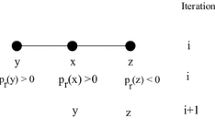Abstract
In this paper, a numerically stable method of signal subspace estimation based on Householder multistage Wiener filter (HMSWF) is proposed. Numerical stability of the method lies on the fact that the Householder matrix in HMSWF ensures the unitary blocking operation and significantly strengthens the orthogonality of basis vectors, especially in the finite-precision implementation. In the following, we analyze the numerical stability of HMSWF and MSWF based on the correlation subtractive structure (CSS-MSWF) by establishing the equivalence between the forward recursion of MSWF and the Arnoldi algorithm in numerical linear algebra. Besides, the equivalence between HMSWF and the Householder QR decomposition (QRD) on the Krylov matrix underlying in MSWF is directly established. Based on the relationship, two theoretical upper bounds of the orthogonality error of basis vectors in signal subspace are obtained and it is demonstrated that the orthogonality of basis vectors based on HMSWF is perfectly preserved by the numerically well-behaved Householder matrix, and the corresponding signal subspace estimation is much more numerically stable than that based on CSS-MSWF. Simulations show the numerical stability of the proposed method of signal subspace estimation by HMSWF.
Similar content being viewed by others
References
Goldstein J S, Reed I S, Scharf L L. A multistage representation of the Wiener filter based on orthogonal projections. IEEE Trans Inf Theory, 1998, 44: 2943–2959
Guerci J R, Goldstein J S, Reed I S. Optimal and adaptive reduced-rank STAP. IEEE Trans Aerospace Electr Syst, 2000, 36: 647–663
Witzqall H E, Goldstein J S. Detection performance of the reduced-rank linear predictor ROCKET. IEEE Trans Acous Speech Signal Process, 2003, 51: 1731–1738
Huang L, Wu S J, Feng D Z, et al. Computationally efficient direction-of-arrival estimation based on partial a prior knowledge of signal sources. Eurasip J Adv Signal Process, 2006, (1): 7
Huang L, Wu S J, Feng D Z, et al. Low complexity method for signal subspace fitting. IEE Electr Lett, 2004, 40: 847–848
Huang L, Wu S J, Li X. Reduced-rank MDL method for source enumeration in high-resolution array processing. IEEE Trans Signal Process, 2007, 55: 5658–5667
Liang J L, Liu D, Zhang J Y. Joint frequency, 2-D DOA, and polarization estimation using parallel factor analysis. Sci China Ser F-Inf Sci, 2009, 52: 1891–1904
Honig M L, Xiao W. Performance of reduced-rank linear interference suppression. IEEE Trans Inf Theory, 2001, 47: 1928–1946
Joham M, Zoltowski M D. Interpretation of the multi-stage nested Wiener filter in the Krylov subspace framework. Technical Report, TR-ECE-00-51, Purdue University, 2000
Ricks D C, Goldstein J S. Efficient architectures for implementation adaptive algorithms. In: Proc 2000 Anten Applica Symposium. Monticello, IL, USA, 2000. 29–41
Werner S, With M, Koivunen V. Householder multistage Wiener filter for space-time navigation receivers. IEEE Trans Aerospace Electron Syst, 2007, 43: 975–988
Drkosova J, Greenbaum A, Rozloznik M, et al. Numerical stability of GMRES. BIT, 1995, 34: 309–330
Greenbaum A, Rozloznik M, Strakos Z. Numerical behaviour of the modified Gram-Schmidt GMRES implementation. BIT, 1997, 39: 706–719
Golub G, Loan C V. Matrix Computations. 3rd ed. Baltimore: The Johns Hopkins University Press, 1996
Wilkinson J H. The Algebraic Eigenvalue Problem. Oxford: The Clarendon Press, 1965
Attallah S, Abed-Meraim K. Fast algorithms for subspace tracking. IEEE Trans Signal Process Lett, 2001, 8: 203–206
Author information
Authors and Affiliations
Corresponding author
Rights and permissions
About this article
Cite this article
Zhuang, X., Cui, X., Lu, M. et al. Numerically stable method of signal subspace estimation based on multistage Wiener filter. Sci. China Inf. Sci. 53, 2620–2630 (2010). https://doi.org/10.1007/s11432-010-4103-9
Received:
Accepted:
Published:
Issue Date:
DOI: https://doi.org/10.1007/s11432-010-4103-9




